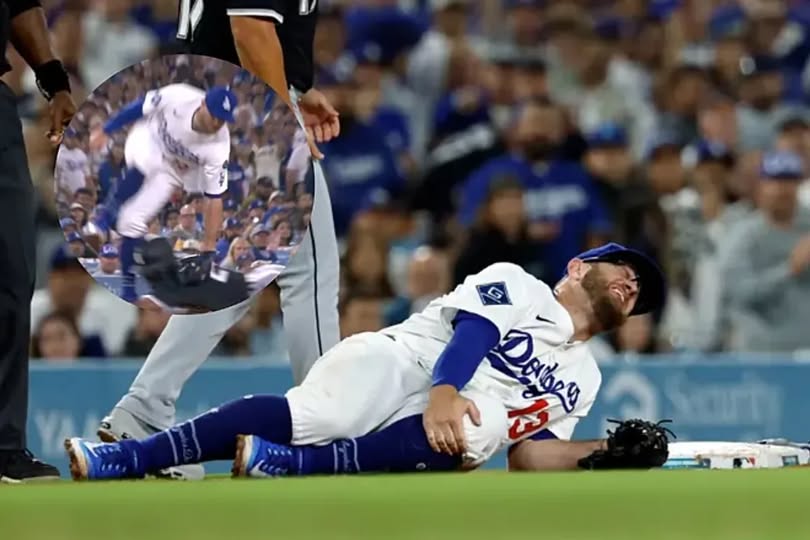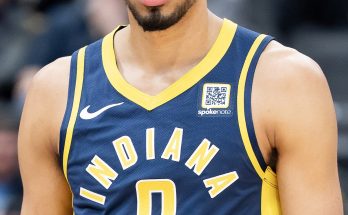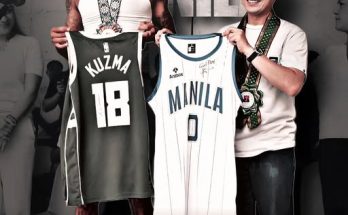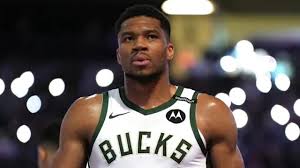Los Angeles Dodgers third baseman Max Muncy left fans gasping in horror on Wednesday night when a terrifying collision at third base resulted in an injury that had fans fearing the worst. The scene unfolded during a high-stakes moment against the Chicago White Sox, mere pitches before Clayton Kershaw recorded his historic 3,000th career strikeout. What began as a routine defensive play quickly turned into a nightmare scenario that shook Dodger Stadium—and risked sidelining one of their most potent offensive threats.
It was the sixth inning when Chicago’s Michael A. Taylor attempted to steal third base. Dodgers catcher Will Smith delivered a sharp throw to Muncy, who was expertly positioned to apply the tag. But as Taylor slid in head-first, his helmet slammed into Muncy’s left knee, while the third baseman’s cleats remained planted in the turf—causing his knee to buckle in a horrifying, unnatural direction . The impact was audible and brutal, and Muncy collapsed to the ground in visible pain, clutching his knee. Broadcast television even withheld replay, with announcer Orel Hershiser flashing a cautionary warning: “the knee pretty much goes the opposite way. It’s a tough injury to watch”
Medical staff rushed onto the field, and after several tense moments, Muncy was helped off, barely able to bear weight on his leg (. As he limped to the dugout, the atmosphere shifted instantly from celebration—about Kershaw’s moment—to fear and concern. Viewers watched in silence as he was escorted away, the cheers giving way to a hush filled with dread.
Dodgers manager Dave Roberts later shared that initial tests were “optimistic,” with hopes that the injury was no more than a sprain. That said, Muncy was scheduled for an MRI the following day to determine the full extent . When the team’s announcement came, it confirmed a left knee bone bruise and a placement on the 10-day injured list . Muncy himself estimated a six-week absence—rocking Dodger fans who rely heavily on his explosive offense .
This chilling image and injury were made all the more disturbing by the context. Earlier that night, Kershaw had just achieved his landmark 3,000th strikeout, a historic milestone that could have defined the evening. Instead, the buzz shifted dramatically to Muncy’s downed form and the gnawing anxiety around his status. The replay—or lack thereof—was telling: if broadcasters feared showing it, fans feared even more.
In the clubhouse, Kershaw couldn’t disguise his concern. “We’re all thinking about Munce right now,” he said. “He’s a huge part of our team… We’re all holding our breath that Munce is going to be OK” . His sentiment resonated with a team that has leaned on Muncy heavily throughout the season.
Muncy’s journey this year has been defined by resilience and power. Though he had a slow start, from May onwards he slashed .329/.425/.570, launching eight home runs and collecting 27 RBIs in that span . His surge became critical to the Dodgers’ offensive engine—each homer a spark, each walk a momentum shift.
But Muncy is no stranger to the trauma of injury. In 2021, he dislocated his elbow and tore a ligament in a collision at first base, sidelining him for the playoffs . His durability has been tested again: in 2024, he endured an oblique strain and displaced rib that kept him off the field for much of the season . Yet each time, he has clawed his way back, finishing with clutch production and a renewed appreciation for the game.
That personal perspective—the gratitude born from adversity—underscores what this current injury means. Muncy is 34 years old, and the crossroads between perseverance and recovery becomes starker with age. A six-week absence may seem possible, but what of the lingering effects, the setbacks in timing, the mental toll of another body-wrenching injury?
Fans, already jittery, fell into a spiral of worst-case scenario speculation after seeing the replay on social media. Posts warned of ACL or MCL damage based on how his knee buckled. Naturally, such comparisons fueled fears across Dodgers Nation . One poignant fan comment captured it: “I’m not a doctor, but that is exactly the way my knee bent when I had a clean tear of my ACL” —that emotional echo resonated with thousands.
That panic was amplified by Muncy’s stat line. With 200+ career homers—including over 200 as a Dodger—and delivering a .230 average with 208 home runs and 590 RBIs as of June , he isn’t just a consistent slugger—he is the backbone of their lineup. His absence leaves a void in power, discipline, and experience.
The Dodgers had to act swiftly. With Muncy’s IL placement confirmed, manager Roberts and general manager Andrew Friedman must address both the short-term void and the long-term implications. Infield depth—a mix of Kiké Hernández, Miguel Rojas, and late-game prospects—will have to fill in. But none carry the power or plate discipline Muncy provides. Reports suggest the club may explore trades to shore up third base until his return .
Dodgers’ need for reinforcement isn’t new this summer. The division race remains tight, every win matters, and the postseason push looms. The team’s resilience will be tested not just on the field, but in the boardroom and dugout. How they respond could define the second half of their season.
Yet amid the fear, there’s cautious optimism. The MRI cleared him of structural damage—no torn ligaments, no immediate surgery required . A six-week recovery could align well with late-season return, offering hope that Muncy’s power bat will be back when it counts most.
Moreover, his track record of bouncing back from serious injuries—from elbow ligament tears to oblique strains—speaks to his physical discipline and mental toughness. He’s rebuilt before; he can do it again. Rob Manfred’s rule changes, roster shuffle, and team morale all hinge on how quickly and completely he returns.
Ian Kennedy, the Dodgers athletic trainer, outlined recovery protocols: rest, rehab, pain management, followed by on-field strengthening. But beyond muscle and ligaments, Muncy must overcome fear—the fear every athlete feels when witnessing their body betray them in a split-second collision.
Nevertheless, Muncy’s career has been built on noir mental grit. From being a fifth-round pick to becoming an All-Star, slugger, and postseason performer, he’s thrived under pressure . He’s grown through faith in his preparation, in his body, and in his role.
Dodger fans, day-to-day, live in suspense now. Every game without him highlights his absence: the missing DP depth, the strike-zone control, the bat-you-can-leverage. But each day of rest and rehab also brings hope that when October arrives, he’ll be back.
The collision happened on a night of celebration. Instead of focus solely on Kershaw’s milestone, the injury has dominated the narrative—because Muncy matters just as much. And though fans held their breath earlier, they might now hold onto hope. Muncy is expected to get treatment around the clock, be held to cautious benchmarks, and return stronger.
What remains is patience—and collective prayer. The next MRI outcomes, timeframe updates, and rehab progress will shape this season’s trajectory. But one thing is clear: Muncy means something deep to this team, this fanbase, and this moment. His pain resonated in every Dodger fan’s chest; his comeback will lift them right back up.
If ever there was a player to turn crisis into catalyst, it’s Max Muncy. His story isn’t done. It’s just paused—and when he returns, expect that powerful swing, that icy batting eye, that veteran presence to once again propel the Dodgers into October contention.
For now, Dodger Stadium remains filled with hopeful murmurs: Here’s to a full recovery—and a powerful return.




